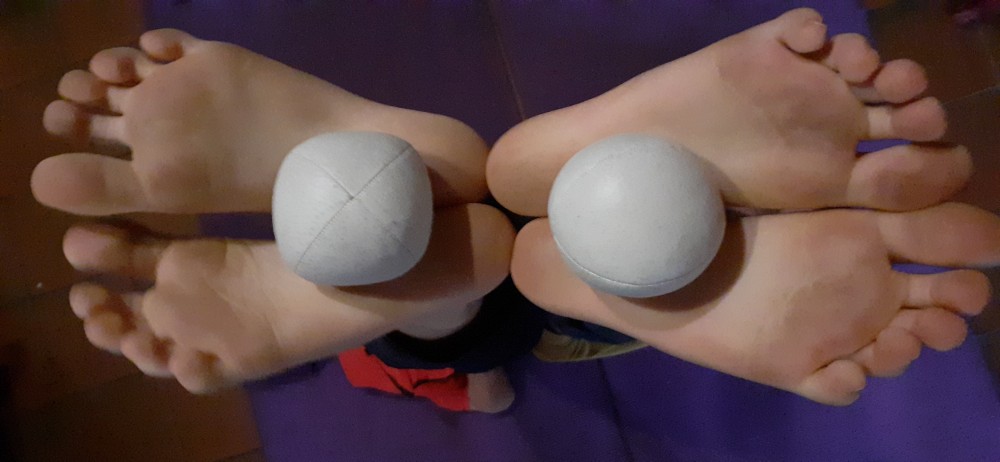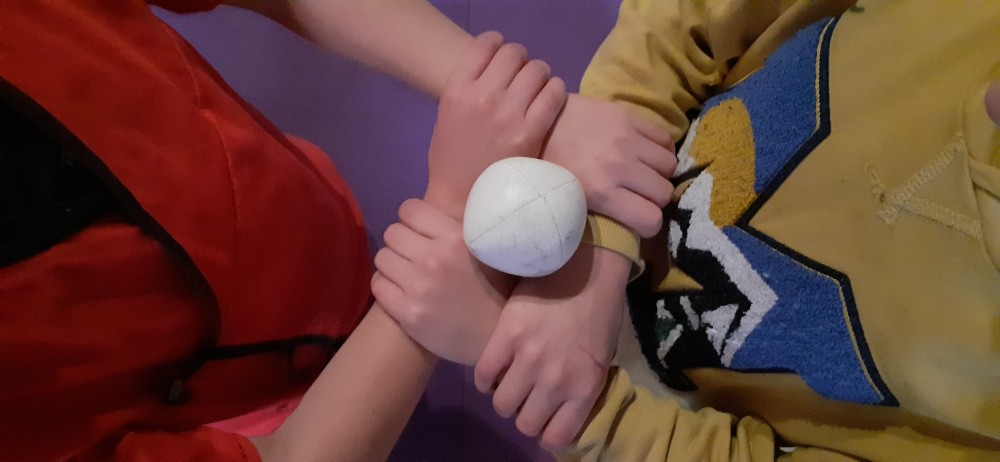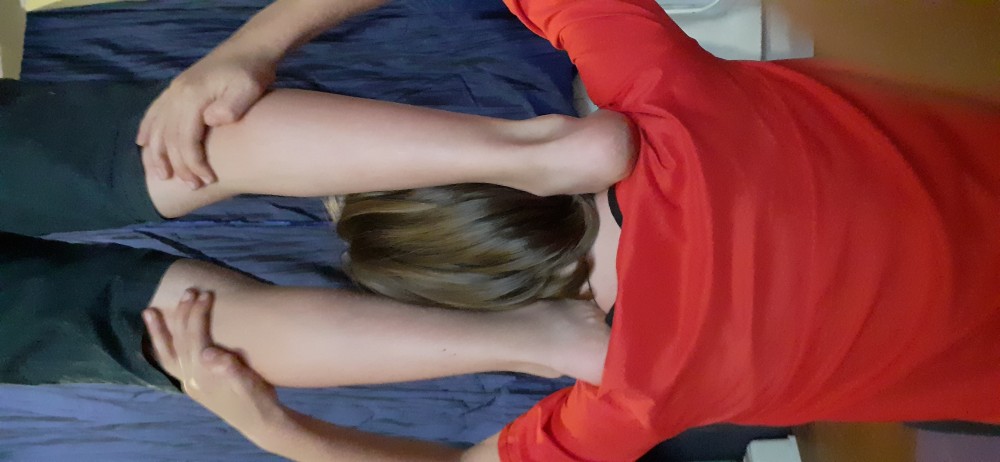Circustherapie: Circus als therapeutisch medium binnen de kinder en jeugdpsychiatrie.
CIRCUSTHERAPIE: Circus als therapeutisch medium binnen de kinder- en jeugdpsychiatrie.
(c) Tekst, foto’s Victoria Pompe

Al drie jaar is er een circustherapeut werkzaam op de afdeling kinder- en jeugdpsychiatrie, te Kortrijk. Elke week krijgen de patiënten sessies partneracrobatie of jongleren. Binnenkort zal het mogelijk zijn om wekelijks in de trapeze te hangen! Maar kan circus gebruikt worden als therapie? Wat houdt dat in en waarin schuilt de therapeutische waarde?
Om een antwoord op deze vragen te geven, deed de auteur onderzoek naar de fundamentele elementen van circustherapie.
Steeds vaker wordt het leren van circustechnieken ingezet om persoonlijke ontwikkeling en sociale verandering te bevorderen. Dit noemt men “sociaal circus”. Circustherapie neemt één stap verder. Deze lichaamsgerichte therapievorm gebruikt circustechniek in functie van het psychisch welzijn van de patiënten. Om dit te bereiken wordt het proces boven het product geplaatst. De focus ligt niet op het halen van een hoog technisch kunnen, wel op het in staat stellen van de patiënten om een zicht te verkrijgen op hun problematiek.
Er is weinig onderzoek gedaan naar circustherapie, vooral binnen een psychiatrische context. Daarom was het nodig om het circustherapielandschap te verkennen met de hoop op verder onderzoek in de toekomst. Bij deze specifieke onderzoeksvraag werden de fundamentele elementen van circustherapie besproken:
1. Het lichaam - het lichaamsbeeld, zelfbeeld en (zelf)vertrouwen spelen een centrale rol in deze therapie. Bij het bouwen van een menselijke piramide bijvoorbeeld, kan veel teweeg gebracht worden bij een persoon. Angst en wantrouwen komen vaak op de voorgrond. De therapeut maakt tijd en ruimte om alle gevoelens en gedachten te exploreren. Hoe is het om iemand op je rug te laten staan terwijl iedereen naar je kijkt?
2. Taal - Hoe geef je feedback aan anderen? Hoe belangrijk is het om plezier te beleven door te lachen of woorden van aanmoediging of bewondering te mogen roepen? Er wordt natuurlijk verbale taal gebruikt maar lichaamstaal is even belangrijk bij deze therapie. Hoe geef je iemand een gevoel van vertrouwen door aanraking? Aanraking heeft verschillende functies binnen de therapie. Voor een jongen die bang is om een salto te maken, kan de hand van een vanger op zijn rug een gevoel van veiligheid, vertrouwen of geruststelling brengen. Een hand op de rug bij de landingsfase bevordert stabiliteit. Een ‘high five’ nadien van een medepatiënt kan het zelfvertrouwen versterken voor beide partijen.
3. Risico’s – leren de veiligheid inschatten is een essentieel onderdeel van circustherapie. Patiënten worden gevraagd om hun eigen grenzen in te schatten, te respecteren, aan te geven en (in bepaalde mate) te verleggen. Dit is niet altijd eenvoudig, aangezien er een groot fysiek risico schuilt in het balanceren op een koord e.d. Een matige vorm van pijn hoort hier soms bij. Het is aan de therapeut om de patiënten te begrenzen als dat hen zelf niet lukt, of aan te moedigen om grenzen te verleggen. Dit om de veiligheid te garanderen maar ook de psychische processen van de deelnemers te bevorderen.
4. Een circusact of voorstelling maken als onderdeel van de therapie - Een creatief project kan een bijdrage aan het genezingsproces leveren maar moet echter grondig overwogen worden. Het maken van een ‘product’ binnen een psychologisch traject kan enerzijds de kans bieden om vanop een afstand, emoties en problemen te kaderen. Dit gebeurt bij het (her)uitspelen van relevante thema’s tijdens improvisatie en repetitie. Anderzijds riskeert de patiënt om een ‘kunstmatige’ blik op de eigen problematiek te ontwikkelen of om niet om te kunnen gaan met het waardeoordeel van de toeschouwers. De beslissing om een show te creëren wil niet zeggen dat het ook getoond moet worden. De therapeut moet zorgen dat de patiënt(en) op elk moment de keuze hebben om het proces te onderbreken. Dit zelfs tot op het laatste moment. Het is belangrijk om in te schatten of elke deelnemende patiënt voldoende voeling heeft met zijn eigen grenzen. Na afloop van het toonmoment volgen er verschillende nabesprekingen tussen publiek, patiënten en therapeuten.


Case Study: Marion (pseudoniem) – 11 jaar, opgenomen omwille van een hechtingsstoornis, ADHD en autisme spectrumstoornis.
Marion volgde meermaals per week circustherapie en na een tijdje wilde ze met botsballen jongleren. Ze kreeg zes ballen in verschillende kleuren. Langzaam aan, koppelde ze elke kleur aan een emotie waar ze vaak mee bezig was (angst, boosheid, blijheid, liefde, verdriet en donkere gedachten). Ze begon te improviseren met de ballen. Ze gooide ze tegen de muren, ving ze op en soms liet ze de ballen vallen. Na een tijd had Marion een uniek bewegingspatroon ontwikkeld voor elke bal. De therapeut faciliteerde dit proces door te vragen naar Marions beleving bij het werken met de ballen en welke beelden en gedachten daarmee werden opgeroepen. Dit gebeurde vooral bij onverwachte voorvallen, bijvoorbeeld als een bal niet gevangen werd en weg rolde. Voor Marion, keerde de liefde altijd terug als die viel, terwijl haar ‘donkere gedachten’ zich vaak in een hoekje verstopten. Marion werkte voor een aantal weken rond deze thema’s en uiteindelijk maakte ze een act van zes minuten. Ze besloot om dit aan twee groepsleiders te tonen. Marion was ontzettend trots op haar creatie! Deze speelse manier van werken creëerde een zekere afstand tot haar emoties. Hierdoor kreeg ze de ruimte om haar problemen objectiever te bekijken.
Deze case study is één voorbeeld van hoe circus gebruikt kan worden als therapeutisch medium. Er zijn uiteraard veel andere manieren naargelang de individuele hulpvraag en de patiënt zelf. Gelukkig heeft circus als discipline veel mogelijkheden: van trapeze tot jongleren, van koordlopen tot handenstand. Iedere patiënt heeft de vrijheid om te werken op zijn eigen tempo en zijn eigen manier. De therapeut werkt met een open blik, observeert de dynamieken, (lichaams-)taal en ruimtegebruik. Van daaruit werkt ze zowel sturend als volgend, en evalueert en herhaalt dit proces doorheen de sessie. Hoe dit in de werkelijkheid gaat binnen circustherapie is nog niet grondig onderzocht. De scriptie van de auteur was o.a. geschreven als uitnodiging aan collega’s om circus als therapie verder te onderzoeken, want er zit nog veel moois verborgen onder het zaagsel!
Bibliografie
Bibliography
Acarón, T. (2016). Therapeutic Performance: When Private Moves into Public. In V. Karkou, S. Oliver, & S. Lycouris, The Oxford Handbook for Dance and Wellbeing (p. Hoofdstuk 12). Oxford: Oxford University Press.
Alana, L. (2019, 12 30). Circus as a Healing Art: What Polyvagal Theory Teaches us About Why Circus Works. Retrieved from Yes and Brain: https://yesandbrain.com/blog/polyvagalcircus Almond, R. (2011). Reading Freud's "the Dynamics of Transference" one hundred years later. Journal
of the American Psychoanalytic Association Vol. 59, Issue 6, 1129-56.
Alvarez, M. (2014). On Freud’s “The Dynamics of Transference”. Retrieved 12 11, 2017, from
Demente: https://maupsicologia.wordpress.com/2014/04/05/on-freuds-the-dynamics-of-
the-transference-1912/
Berk, T. (2005). Leerboek Groepspsychotherapie. Utrecht: Tijdstroom Uitgeverij.
Biru, A. (2019). The Development of the Features of Positive Youth Development Among Youth Who
Are Practicing Circus Art at Fekat Circus Club in Addis Ababa . Addis Ababa, Ethiopia: Addis
Ababa University.
Bolton, R. (2004). Why Circus Works. Perth: Murdoch University.
Capello, P. (2016). BASCICS: An Intra/ Interactional Model of DMT with the Adult Psychiatric Patient.
In S. Chaiklin, & H. Wengrower, The Art and Science of Dance/ Movement Therapy: Life is
Dance Second Edition (pp. 77-102). New York: Routledge.
Casement, P. (2002). Learning from our Mistakes: Beyond Dogma in Psychoanalysis and
Psychotherapy. Hove: Brunner-Routledge.
Castro-Fonseca, A., & Perrin, S. (2011). The clinical phenomenology and classification of child and
adolescent anxiety. In W. K. SIlverman, & A. P. Field, Anxiety Disorders in Children and
Adolescents (pp. 25-55). Cambridge: Cambridge University Press.
Collins. (1987). The New Collins Dictionary and Thesaurus in One Volume. London and Glasgow:
William Collins Sons & Co Ltd.
De Mijolla, A. (2005). International Dictionary of Psychoanalysis. Michigan: Thompson Gale.
De Preester, H. (2005). Ways of learning: Two phenomenological logics and the mirror neurons
theory. In H. De Preester, & V. Knockaert, Body Image and Body Schema: Interdiciplinary
Perspectives on the Body (pp. 45-64). Amsterdam: John Benjamins B. V.
De Preester, H., & Knockaert, V. (2005). Body Image and Body Schema: Interdisciplinary Perspectives
on the Body. Amsterdam: John Benjamins B.V.
45
De Valk, A. (2017). Het kader in beeld: Beschouwingen over een psychoanalytisch kader voor beeldende therapie. In J. Demuynck, & A. Geldhof, Creatieve Therapie (pp. 113-122). Leuven: Acco.
Demuynck, J. (2016). Inleidingen in de Lacaniaanse Psychoanalyse. Leuven: Acco.
Depraz, N. (2005). Radical Embodiment Experimenting Risks. In H. De Preester, & V. Knockaert, Body
Image and Body Schema: Interdisciplinary Perspectives on the Body (pp. 173-186).
Amsterdam: John Benjamins B.V.
Desanghere, S. (2016). "Look At Me!". Gent: Circusplaneet v.z.w.
Dickens, C. (1903). Sketches by Boz. London: Chapman & Hall.
Durkin, J., Jackson, D., & Usher, K. (2020). Touch in times of COVID-19: Touch hunger hurts. Journal
of Clinical Nursing, 1-2.
EADMT. (2020, 11 23). What is Dance Movement Therapy? Retrieved from EADMT:
https://www.eadmt.com/?action=article&id=22
Fazelian, P., & Azimi , S. (2013). World Conference on Psychology and Sociology 2012 - Creativity in
Schools. Procedia - Social and Behavioral Sciences, 719-723.
Foulon, M. (2017). Een danstherapie geïnspireerd door de lacaniaanse psychoanalyse. In J.
Demuynck, & A. Geldhof, Creatieve Therapie (pp. 143-158). Leuven: Acco.
Freud, S. (1912b). Dynamiek van de Overdracht. In S. Freud, (2006) Werken 5 (pp. 456-466).
Amsterdam: Boom.
Freud, S. (1916). Leonardo Da Vinci - a psychosexual study of an infantile reminiscence. New York:
Moffat, Yard and Company.
Freud, S. (1961). Beyond the Pleasure Principle. New York: W. W. Norton and Company.
Geerardyn, F., & Walleghem, P. (2005). Françoise Dolto’s clinical conception of the unconscious body
image and the body schema. In H. De Preester, & V. Knockaert, Body Image and Body Schema: Interdisciplinary Perspectives on the Body (pp. 299-310). Amsterdam: John Benjamins B. V.
Ginsburg, K. R. (2007, 12 7). The Importance Of Play In Promoting Health, Child Development And Maintaining Strong Parent - Child Bonds. Pediatrics, 119-182. Opgehaald van Circus Play Cafe: https://www.circusplaycafe.com/why-play-is-important
Glowinski, H., Marks, Z., & Murphy, S. (2001). A compendium of Lacanian Terms. London: Free Association Books.
Gray, P. (2011). The Decline of Play and the Rise of Psychopathology in Children and Adolescents. The American Journal of Play, 443-463.
46
Guéguen, P. (2014). Transference: A Paradoxical Concept. LC Express Vol 2, Issue 12, 1-9.
Güldner. (2017). Gezonde en kwetsbare positieve zelfwaardeing bij kinderen: kenmerken, functie en
regulatie. Amsterdam: Vrije Universiteit.
Hackney, P. (2002). Making Connections, Total Body Integration Through Bartenieff Fundamentals.
London: Routledge.
Hartley, J. R. (2013). Guided Practices in Facing Danger: Experiences of Teaching Risk. London:
Central School of Speech and Drama.
Hayes, J. (2004). The Experience of Student Dancers in Higher Education in a Dance Movement
Therapy Group with reference to Choreography and Performance (Doctoraat). Hatfield:
University of Hertfordshire.
Heller, C., & Taglialatela, L. (2018). Circus Arts Therapy® Fitness and Play Therapy Program Shows
Positive Clinical Results. International Journal of Play Therapy, 69-77.
HKRBooks.com. (2021, 01 04). lalangue-sinthome-jouissance-and-nomination. Opgehaald van Hong
Kong Review of Books: https://hkrbooks.com/2017/04/21/lalangue-sinthome-jouissance-
and-nomination/
Hoens, D. (2017). Het Medium (h)eerst. Over Lacaniaanse psychoanalyse en creatieve therapie. In J.
Demuynck, & A. Geldhof, Creatieve Therapie (pp. 39-49). Leuven: Acco. Holowchak, M. (2011). What Play, Games, and Sport Reveal about Players, Gamesmen, and
Sportsmen - A Freudian Analysis. The journal of the American Academy of Psychoanalysis
and Dynamic Psychiatry, 695-715.
Lacan, J. (1981). The Four Fundamental Concepts of Psychoanalysis - The Seminar of Jacques Lacan
Book XI. New York: W. W. Norton and Company, Inc.
Lam, L. (2016). Pantomime. Basingstoke: Tor: Pan Macmillan.
Lax, R. (1959). The Circus of the Sun. New York: Journeyman Press.
Levy, J. (1988). Dance/movement therapy. A healing art. Reston: NDA AAHPERD.
Liebmann, A., & Beissbarth, E. (1997). Women's Circus: Leaping off the Edge. Footscray, Community
Arts Centre, Melbourne: Spinifex.
Ma, Y. (October 2015). Lacan on Gaze. International Journal of Humanities and Social Science, 125-
137.
Meilman, A. (2018, Dec). Circus Arts as Expressive Arts Therapy. Cambridge, Massachusetts:
Graduate School of Arts and Social Sciences (GSASS), Lesley University. Retrieved from
www.lesley.edu.
Morgenstern, E. (2011). The Night Circus. London: Vintage.
47
Pallaro, P. (1999). Authentic Movement: Essays by Mary Starks Whitehouse, Janet Adler and Joan Choderow. London: Jessica Kingsley Publishers.
Perelberg, R. J. (2008). Time, Space and Phantasy. Hove: Routledge.
Pulles, C. G. (1978). Helpend Spel - Therapie voor kinderen, theorie en voorbeelden. Bloemendaal:
Uitgeverij H. Nelissen B.V.
Sharp, C. (2004). Developing young children’s creativity: What can we learn from research? Slough:
NFER.
Sherborne. (2021, 01 01). Sherborne Developmental Movement. Opgehaald van Sherborne
Association UK: https://www.sherbornemovementuk.org/
Shreeves, R. (2006). Full Circle: From Choreography to Dance Movement Therapy and Back. In H.
Payne, Dance Movement Therapy: Theory, Resarch and Practice Second edition (pp. 232-
245). London: Routledge.
social-circus.com. (2020, 01 03). social-circus.com. Retrieved from social-circus.com: http://social-
circus.com/
Stamenov, M. I. (2005). Body schema, body image,and mirror neurons. In H. De Preester, & V.
Knockaert, Body Image and Body Schema: Interdisciplinary Perspectives on the Body (pp. 21-
43). Amsterdam: John Benjamins B.V.
Starks Whitehouse, M. (1999). The Transference and Dance Therapy. In P. Pallaro, Authentic
Movement: Essays by Mary Starks Whitehouse, Janet Adler and Joan Chodorow (pp. 63-72).
London: Jessica Kingsley Publishers.
Taeymans, R., & Van Bouchout, L. (2019). Circomotoriek met Kleuters. Kalmthout: Pelckmans Pro. Thibierge, S., & Morin, C. (2010). The Self and the Subject: A Psychoanalytic Lacanian Perspective.
Neuropsychoanalysis, 63-75.
Topping, K., & Ehly, S. (1998). Introduction to Peer-Assisted Learning. Mahwah,: Lawrence Erlbaum
Associates Inc., Publishers.
Traversier, T. (2013). Françoise Dolto en de Psychoanalyse Buiten Het Kader. Twee
Praktijkvoorbeelden. Psychoanalytische Perspectieven, 321-339.
Tuffery, H. (2011). Are you looking at me? The reciprocal gaze and art psychotherapy. ATOL: Art
Therapy Online, 1-21.
Van Bunder, D., & Van de Vijver, G. (2005). Phenomenology and psychoanalysis on the mirror stage:
Different metaphysical backgrounds on body image and body schema. In H. De Preester, & V. Knockaert, Body Image and Body Schema: Interdisciplinary Perspectives on the Body (pp. 253-271). Amsterdam: John Benjamins B. V.
48
Van Coillie, G., & Malfait, R. (1990). Dynamisch Ontspannen: Basisreeks Bio-energetica. Leuven: ACCO.
Van der Straeten, M. (2017). Diagnostiek en Dramatherapie vanuit Psychoanalytisch Perspectief. In J. Demuynck, & A. Geldhof, Creatieve Therapie (pp. 161-173). Leuven: Acco.
Voruz, V. (2017). Kunst Als Oplossing. In J. Demuynck, & A. Geldhof, Creatieve Therapie (pp. 25-38). Leuven: Acco.
Wengrower, H. (2016). The Creative-Artistic Process in Dance Movement Therapy. In S. Chaiklin, , & H. Wengrower, The Art and Science of Dance Movement Therapy: Life is Dance (pp. 13-32). New York: Routledge.
Werbart, A. (2014). The art of freedom: Seven psychoanalytic theses on creativity and boundaries. In E. Sala, Art and freedom: Psychoanalytical reflection on the meaning of creativity. (pp. 102- 111). Krakow: MOCAK (Museum of Contemporary Art in Krakow).
Winnicott, D. (1960). The Theory of the Parent-Infant Relationship. The International Journal of Psychoanalysis, 585-595.
Winship, L. (2020, 01 16). Cirque du Soleil: Luzia review – sometimes bigger really is better. The Guardian.
Zaccarini, J.-P. (2013). Circoanalysis: Circus, Therapy and Psychoanalysis. Stockholm, Sweden: DOCH School of Dance and Circus, Stockholm University of the Arts.
49









